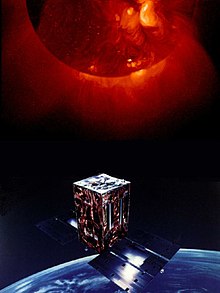
Back يوكو (مسبار) Arabic Jókó Czech Yohkoh German Yohkoh Spanish Yohkoh French Yohkoh Galician יוקו HE Yohkoh Hungarian Yohkoh Italian ようこう Japanese
 Artist concept of the Japanese Yohkoh spacecraft | |
| Names | Solar-A (before launch |
|---|---|
| Mission type | Heliophysics |
| Operator | ISAS / NASA / PPARC |
| COSPAR ID | 1991-062A |
| SATCAT no. | 21694 |
| Website | Yohkoh home page |
| Mission duration | 10 years, 3 months and 14 days (achieved) |
| Spacecraft properties | |
| Launch mass | 390 kilograms (860 lb) |
| Dimensions | 2 m (6 ft 7 in) x 2 m (6 ft 7 in) x 4 m (13 ft) |
| Start of mission | |
| Launch date | 02:30, 30 August 1991 (UTC) |
| Rocket | Mu-3S-II |
| Launch site | Kagoshima M1 |
| End of mission | |
| Disposal | Spacecraft lost accidentally |
| Last contact | 14 December 2001 |
| Decay date | 12 September 2005 |
| Orbital parameters | |
| Reference system | Geocentric |
| Perigee altitude | 516 kilometres (321 mi) |
| Apogee altitude | 754 kilometres (469 mi) |
| Inclination | 31.3° |
| Period | 97.4 min |
Yohkoh (Japanese: ようこう, 'Sunbeam'), known before launch as Solar-A, was a Solar observatory spacecraft of the Institute of Space and Astronautical Science (Japan), in collaboration with space agencies in the United States and the United Kingdom. It was launched into Earth orbit on August 30, 1991 by the M-3SII rocket from Kagoshima Space Center. It took its first soft X-ray image on 13 September 1991, 21:53:40,[1] and movie representations of the X-ray corona over 1991-2001 are available at the Yohkoh Legacy site.
- ^ Ogawara, Yoshiaki; Acton, Loren W.; Bentley, Robert D.; Bruner, Marilyn E.; Culhane, J. Leonard; Hiei, Eijiro; Hirayama, Tadashi; Hudson, Hugh S.; Kosugi, Takeo; Lemen, James R.; Strong, Keith T.; Tsuneta, Saku; Uchida, Yutaka; Watanabe, Tetsuya; Yoshimori, Masato (1992). "The status of YOHKOH in orbit - an introduction to the initial scientific results". Publications of the Astronomical Society of Japan. 44: L41. Bibcode:1992PASJ...44L..41O.